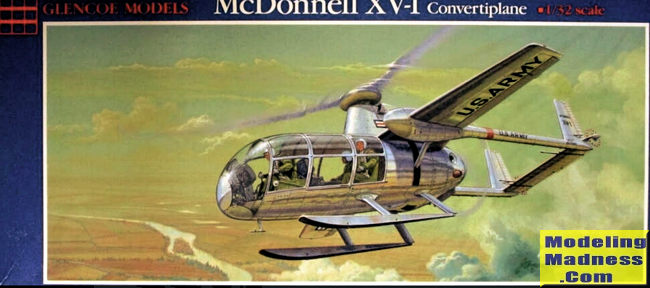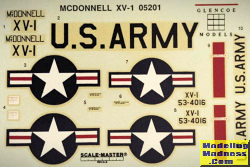
| KIT #: | 05201 |
| PRICE: | $25.00 when reissued |
| DECALS: | One option |
| REVIEWER: | Spiros Pendedekas |
| NOTES: | 1959 tooling |

| HISTORY |
The XV-1 is an experimental Convertiplane developed by McDonnell Aircraft for a joint research program between the United States Air Force and the United States Army to explore technologies to develop an aircraft that could take off and land like a helicopter but fly at faster airspeeds, similar to a conventional airplane. The XV-1 would reach a speed of 200 mph (320 km/h; 170 kn), faster than any previous rotorcraft, but the program was terminated due to the tip-jet noise and complexity of the technology which gave only a modest gain in performance.
| THE KIT |
 With
only two prototypes built, it sounds very interesting (towards astonishing, or
Those Were The Days?) that, back in 1959, a couple of years after the XV-1
project was terminated, ITC issued a 1/32 kit of it! The kit was boxed at
sometime by Kleeware and, finally, in 1988 by Glencoe. Glencoe used to treat us
with such reboxes of older/odder molds, accompanied with great decals (Scalemaster
in most, if not all of the time) and somewhat refined instructions. The specific
copy was “one last piece” found forgotten in 2005 at one of my then “de rigeur”
Athens hobby shops at a normal price. My greed for unusual subjects meant that I
had no other option but to grab this last copy immediately.
With
only two prototypes built, it sounds very interesting (towards astonishing, or
Those Were The Days?) that, back in 1959, a couple of years after the XV-1
project was terminated, ITC issued a 1/32 kit of it! The kit was boxed at
sometime by Kleeware and, finally, in 1988 by Glencoe. Glencoe used to treat us
with such reboxes of older/odder molds, accompanied with great decals (Scalemaster
in most, if not all of the time) and somewhat refined instructions. The specific
copy was “one last piece” found forgotten in 2005 at one of my then “de rigeur”
Athens hobby shops at a normal price. My greed for unusual subjects meant that I
had no other option but to grab this last copy immediately.
The kit comes in a small size, quite sturdy top opening box, but partly beaten up by time, featuring a very attractive box art of the first prototype during a free flight. Upon opening the box, I was greeted with 55 light gray styrene parts, all molded in a single sprue , but cut to smaller sections and sealed in a bag, in order for the contents to fit in the box.
Molding is what you have to expect from a 1959 tooling, very old school, with the parts being thick with soft details, oversize rivets, a number of ejector pin marks and some sink areas at places you don’t want them to be. An amount of flash is also evident and has to be cleaned. Cockpit is sparse, including two seats, instrument panel and side console, all crudely molded. At least, the instrument faces are represented as circular protrusions. Unless you somehow beef-up/refine the interior, your only hope is to let the thick transparencies distort everything. The rest of the details (rotors, prop and aerodynamic surfaces), while definitely not up to today’s standards, are quite acceptable.
Transparencies are overly thick, which, in this case, might be more of a benefit than a shortfall, as they will effectively blurr the sparse interior. Instructions come in the form of a 4-page leaflet, containing a short history of the type, a parts identification list, with the construction spread in 4 quite dense steps, with some basic color callouts given in generic form for the interior.
 The sole
scheme offered is for the first prototype, done in overall silver. Decals,
though superbly printed by Scalemaster (and the much missed Lloyd Jones), have
yellowed with age. A technique that sometimes works is placing the sheet on a
window inner surface facing the strong sun for about a week. If this fails, I
doubt you will be able to locate a dedicated aftermarket sheet, but, since the
insignia and codes are generic, it will not be too difficult to sort yourself
out.
The sole
scheme offered is for the first prototype, done in overall silver. Decals,
though superbly printed by Scalemaster (and the much missed Lloyd Jones), have
yellowed with age. A technique that sometimes works is placing the sheet on a
window inner surface facing the strong sun for about a week. If this fails, I
doubt you will be able to locate a dedicated aftermarket sheet, but, since the
insignia and codes are generic, it will not be too difficult to sort yourself
out.
Instructions want you to first assemble the interior, then add the windows from the fuselage innards (be prepared for some challenging fit there) and join the fuselage halves, trapping the interior in between. The main rotor is then assembled and attached, followed by the rear prop and the wings. The twin booms are next assembled and attached to the winds with the horizontal stabilizer trapped at the rear and the petite tail rotors at their very end. Last, the skis, the clear dome and a few small bits (pitot tube, mass balances and the like) are to be added, ending a build of average complexity.
| CONCLUSIONS |
While not up to today's standards, this is a decent kit of the unconventional Convertiplane. Molding is average but general shapes of parts look correct, interior is sparse but external details are acceptable, instructions are sufficient but decals, while well printed, are aged. The build itself, while not uncomplex, does not seem too complicated, the main concern being fit of parts and, especially, of the thick transparencies.
Interestingly, the kit can still (2024) be found with some effort at very reasonable prices and, since your only other possibility being the discontinued and extremely hard to find 1/72 Anigrand resin offering, the big Glencoe is your only practical option to build a Convertiplane and, under these conditions, is a kit worth tackling.
Happy Modeling!
March 2024
Copyright ModelingMadness.com. All rights reserved. No reproduction in part or in whole without express permission.
Thanks to me for picking this one up when it was on sale.
If you would like your product reviewed fairly and quickly, please contact the editor or see other details in the Note to Contributors.